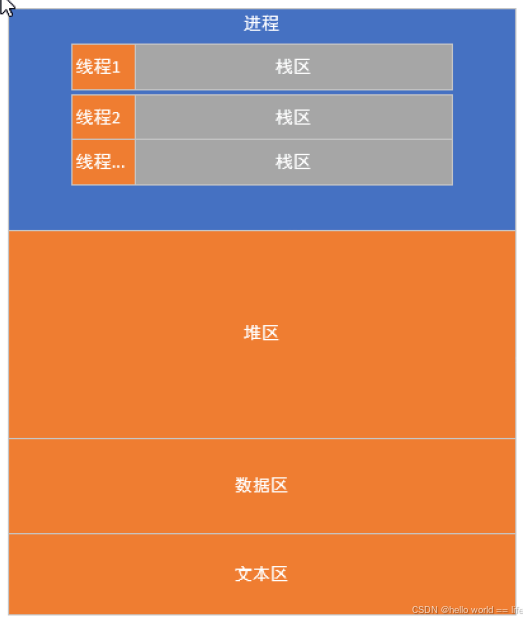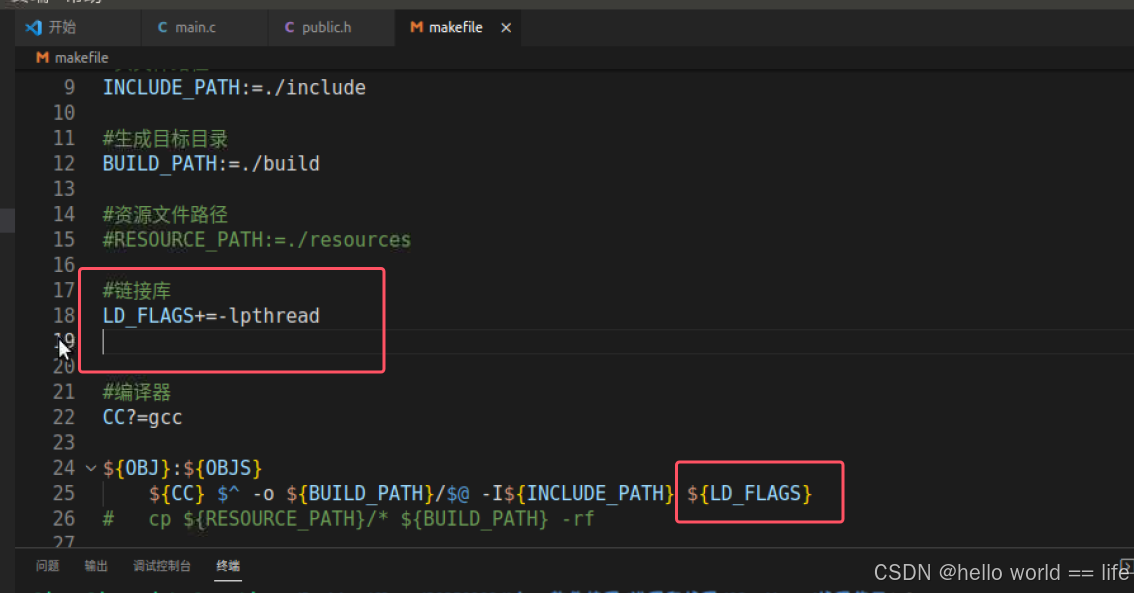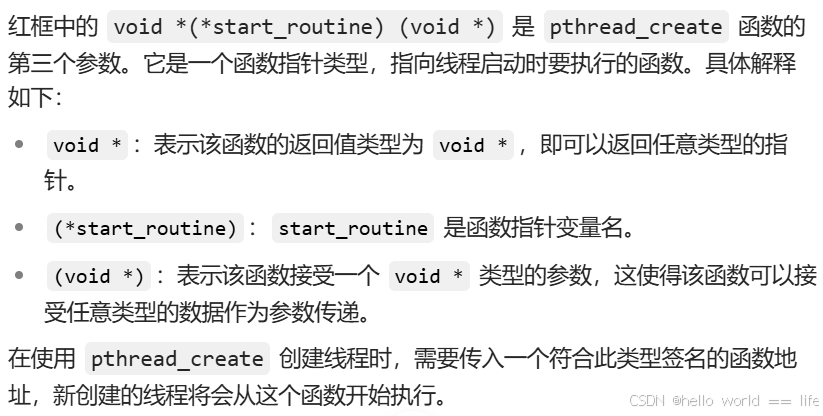1、进程:程序动态执行的过程,包括创建、调度和消亡
2、线程:线程是一个轻量级的进程
3、进程空间包括:
- 文本段、数据段、系统数据段
4、线程空间包括:
- 1. 栈区独享、与进程共享文本段、数据段、堆区
- 2. 线程位于进程空间内部
5、进程和线程的区别
- 进程是操作系统资源分配的最小单元:拥有独立的 文本段、数据段和系统数据段
- 线程是CPU任务调度的最小单元:只有栈区是独立的,其余都是共享的
- 线程依附于进程存在
6、线程的创建
- 每个线程独立拥有8M(默认)栈空间
- 其余的文本段、数据段、堆区都是与进程及进程内的其余线程共享
7、线程的调度
- 线程的调度等价于进程的调度
- 线程是CPU任务调度的最小单元
8、线程的消亡
- 与进程消亡保持一致
- 僵尸线程:等到线程结束需要回收线程空间,否则会产生僵尸线程
9、多进程vs多线程
1.执行效率:多线程 > 多进程
- 线程间的任务切换是再同一片进程内部空间完成任务切换,资源开销较小
- 进程间的任务切换需要映射到不同的物理地址空间,频繁切换资源开销大
2.多任务间通信实现(易用性):多线程 > 多进程
- 多线程拥有共享空间,通信更加方便
- 多进程没有共享空间,需要更为复杂的方法实现多进程间通信
3.多任务间通信机制复杂程度:多进程 > 多线程
- 多线程操作全局变量会引入资源竞争,需要加锁来解决
- 多进程没有资源竞争
4.多任务间通信保证任务的安全性:多进程 > 多线程
- 线程异常崩溃会导致进程崩溃,该进程中的其余线程异常结束
- 进程异常结束,不会影响其余进程
5.综上所述:多进程和多线程实际效率:差不多(半斤八两)
- 一个软件内部不同任务 用多线程
- 不同软件 用多进程
- 简单来说,一个程序就是一个进程,这个程序内部的多个任务,用多线程
- 系统上面的多个任务,用多进程
- 多线程像平面交通,造价成本低,也很方便,但互相之间有干扰(左转直行),所以需要红绿灯(锁的机制)
- 多进程像立体交通,造价成本高,但是没有红绿灯
10、线程相关的函数接口
加头文件<pthread.h>
pthread是一个库,在编译是要加 -l
类比进程中的函数接口:
fork == pthread_create
exit == pthread_exit
wait == pthread_join(1)pthread_create
man 3 pthread_create
int pthread_create(pthread_t *thread, const pthread_attr_t *attr,
void *(*start_routine) (void *), void *arg);
功能:
在调用函数的进程中创建一个线程
参数:
thread:存放线程ID空间的首地址
attr:线程的属性
start_routine:线程函数的入口
arg:传入线程函数的参数
返回值:
成功返回0
失败返回错误数字这里有一个比较难理解的小点:void *(*start_routine) (void *)是pthread_create需要的一个参数,这个参数是一个函数指针,这个函数指针,指向线程启动时要执行的函数。这个函数名为start_routine,括号前面的void *表示这个函数的返回值类型为void *型,括号后面的(void *)表示这个函数需要传入的参数类型是void *型。
简单来说:这是一个 void *型返回值,并且有一个void *型参数的 函数指针
(2)pthread_exit
man 3 pthread_exit
void pthread_exit(void *retval);
功能:
线程退出
参数:
retval:线程退出的值
返回值:
缺省(3)pthread_join
man 3 pthread_join
int pthread_join(pthread_t thread, void **retval);
功能:
回收线程空间
参数:
thread:要回收的线程的ID
retval:存放线程结束状态指针空间的首地址
返回值:
成功返回0
失败返回错误码- 注意:
- pthread_join具有阻塞功能,线程不结束,一直等到线程结束,回收到线程空间再继续向下执行
- pthread_join具有同步功能
练习1:pthread线程使用
#include <stdio.h>
#include "public.h"
void *thread_fun(void *arg)
{
printf("线程(TID:%#x)开始执行\n", (unsigned int)pthread_self());
return NULL;
}
int main(int argc, const char **argv)
{
pthread_t tid;
int ret = 0;
ret = pthread_create(&tid, NULL, thread_fun, NULL);
if (ret != 0)
{
ERR_MSG("fail to pthread_create");
return -1;
}
while (1)
{
}
return 0;
}练习2:pthread线程创建(pro版)
#if 0 和 #endif 中间的内容是基础版
#include <stdio.h>
#include "public.h"
void *thread1(void *arg)
{
printf("线程1(TID:%#lx)正在执行\n", pthread_self());
return NULL;
}
void *thread2(void *arg)
{
printf("线程2(TID:%#lx)正在执行\n", pthread_self());
return NULL;
}
void *thread3(void *arg)
{
printf("线程3(TID:%#lx)正在执行\n", pthread_self());
return NULL;
}
int main(int argc, const char **argv)
{
pthread_t tid[3];
int i = 0;
void *(*pfun[3])(void *) = {thread1, thread2, thread3};
for (i = 0; i < 3; i++)
{
pthread_create(&tid[i], NULL, pfun[i], NULL);
}
for (i = 0; i < 3; i++)
{
pthread_join(tid[i], NULL);
}
#if 0
pthread_t tid1;
pthread_t tid2;
pthread_t tid3;
pthread_create(&tid1, NULL, thread1, NULL);
pthread_create(&tid2, NULL, thread2, NULL);
pthread_create(&tid3, NULL, thread3, NULL);
pthread_join(tid1, NULL);
pthread_join(tid2, NULL);
pthread_join(tid3, NULL);
#endif
return 0;
}练习3:pthread线程创建(pro max版)使用函数指针数组
#include <stdio.h>
#include "public.h"
void *thread(void *arg)
{
int num = (int)arg;
printf("线程%d(TID:%#lx)正在执行\n", num, pthread_self());
return NULL;
}
#if 0
void *thread1(void *arg)
{
printf("线程1(TID:%#lx)正在执行\n", pthread_self());
return NULL;
}
void *thread2(void *arg)
{
printf("线程2(TID:%#lx)正在执行\n", pthread_self());
return NULL;
}
void *thread3(void *arg)
{
printf("线程3(TID:%#lx)正在执行\n", pthread_self());
return NULL;
}
#endif
int main(int argc, const char **argv)
{
pthread_t tid[3];
int i = 0;
int a[3] = {1, 2, 3};
// void *(*pfun[3])(void *) = {thread1, thread2, thread3};
for (i = 0; i < 3; i++)
{
pthread_create(&tid[i], NULL, thread, (void *)(i+1));
}
for (i = 0; i < 3; i++)
{
pthread_join(tid[i], NULL);
}
#if 0
pthread_t tid1;
pthread_t tid2;
pthread_t tid3;
pthread_create(&tid1, NULL, thread1, NULL);
pthread_create(&tid2, NULL, thread2, NULL);
pthread_create(&tid3, NULL, thread3, NULL);
pthread_join(tid1, NULL);
pthread_join(tid2, NULL);
pthread_join(tid3, NULL);
#endif
return 0;
}



